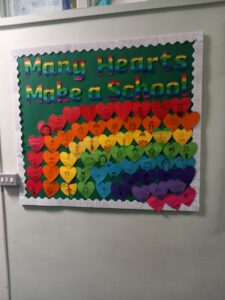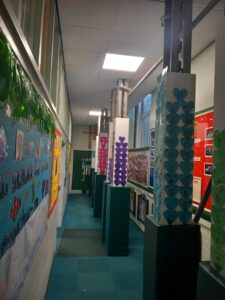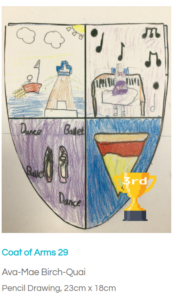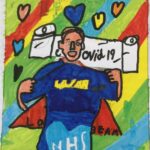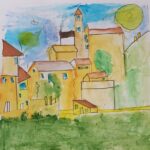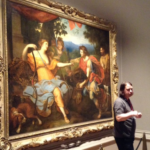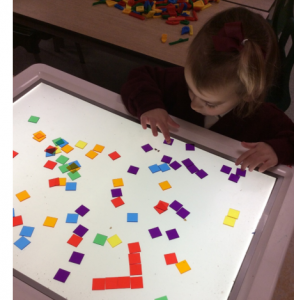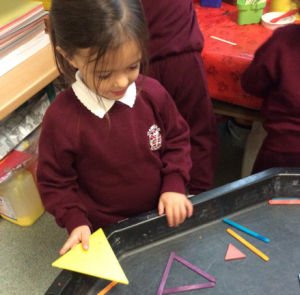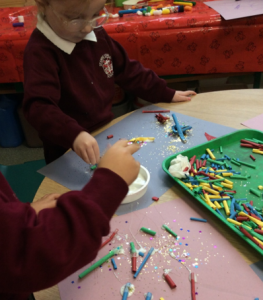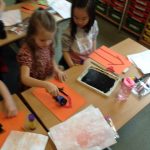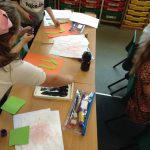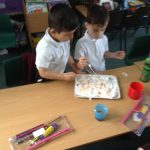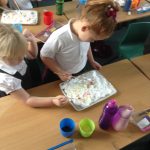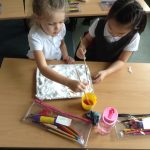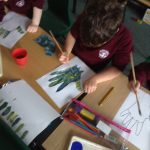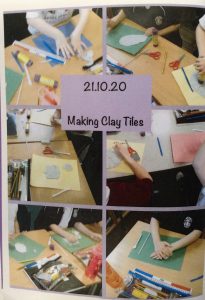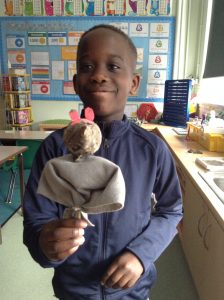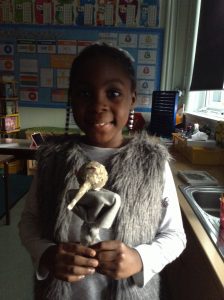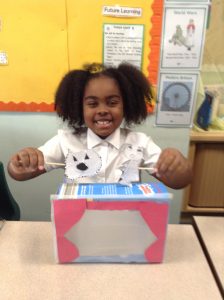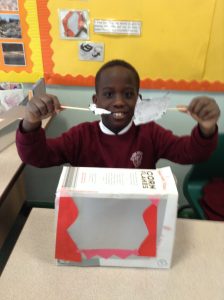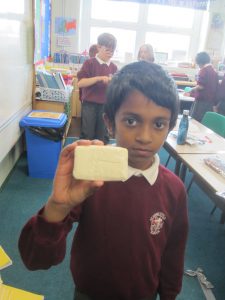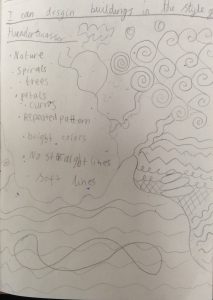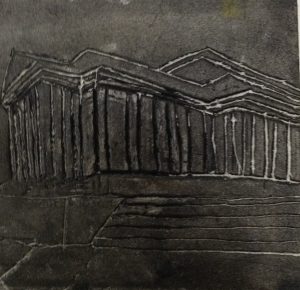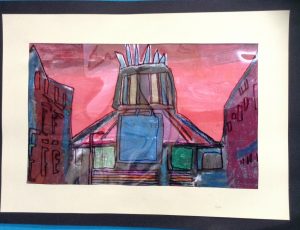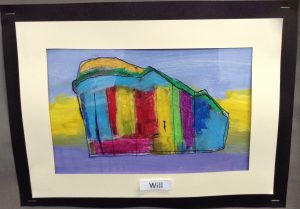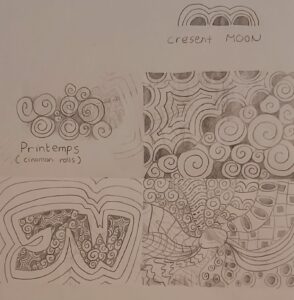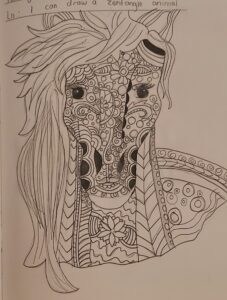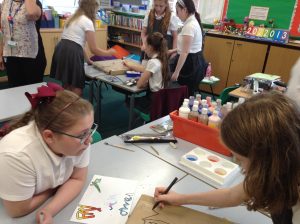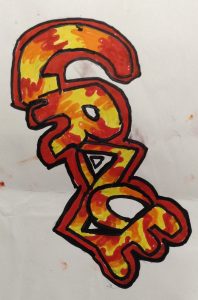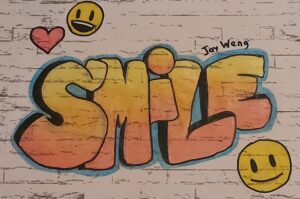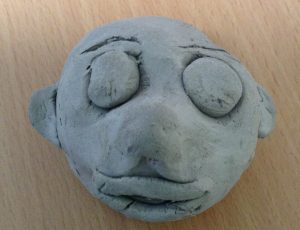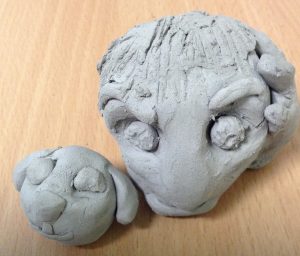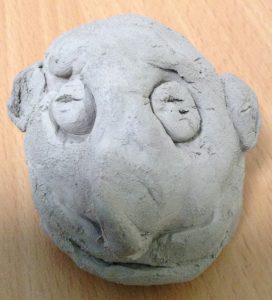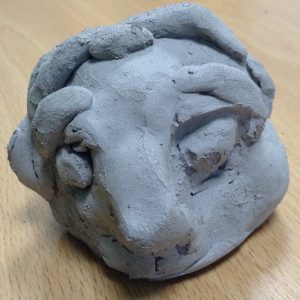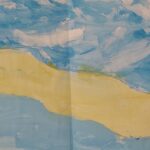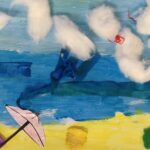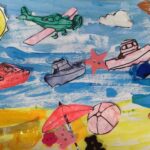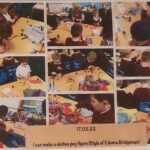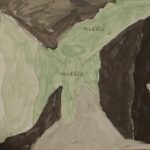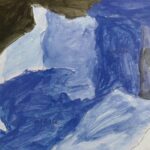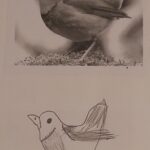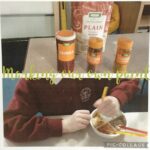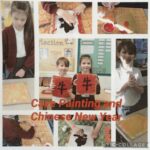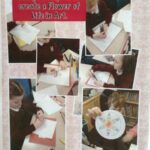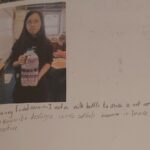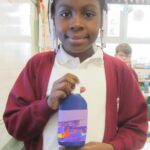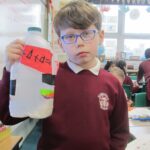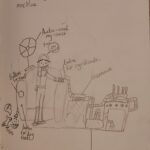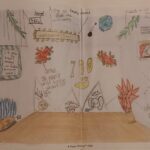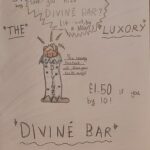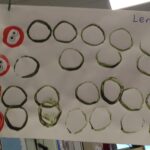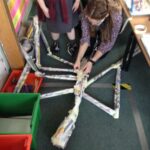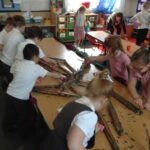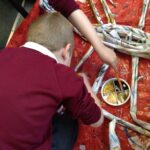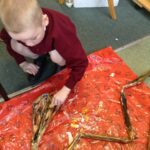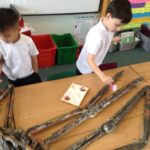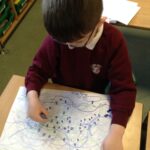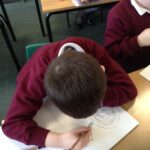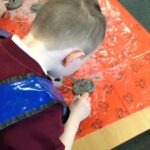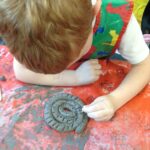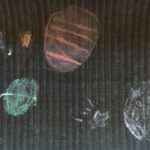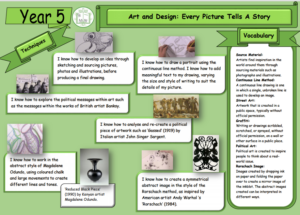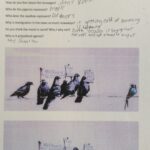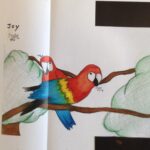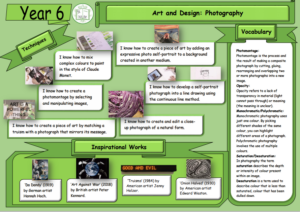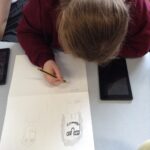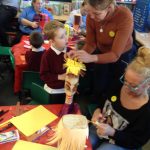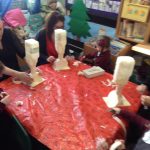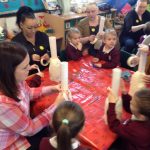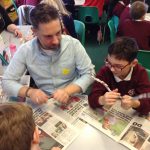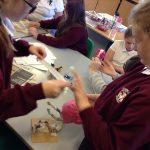My name is Mrs Bell. I am a Reception teacher and the Art and Design lead at St Anne (Stanley). I developed my love of art in primary school where I benefitted from the support of fantastic teachers who promoted creativity in learning. As a child, I was always encouraged to take ownership over my own learning. The mantra at my primary school was to make your work your own. While I studied Art and Design at GCSE-level; I enjoyed being creative in my work across the curriculum. During my A-levels, I enjoyed creative writing in English and French and problem solving in mathematics and biology.
Upon completing my A-levels, I began working towards a BA in Psychology. It was during this time that I came to truly appreciate the essentiality of creativity to both learning and development. I approached each assignment with the objective of originality and as a result, I graduated with first class honours. While my own experience has taught me the value of creativity in learning; the research that I explored as part of my psychology degree served to demonstrate that creativity is a strong predictor of academic success. Upon graduating, I became a student teacher with Liverpool John Moore’s University. It was during this time that I first joined St Anne (Stanley). As a student teacher, the dedication of the staff and the enthusiasm of the children had a huge impact on me. As I am originally from Ireland, the welcoming and caring nature of the St Anne family quickly made St Anne’s a home away from home. While teaching at St Anne’s is a dream come true for me; becoming the Art and Design lead was a real full-circle moment as I now have the opportunity to foster creativity in the children at my school. I have thoroughly enjoyed developing the subject of Art and Design at St Anne’s; I have particularly enjoyed introducing a new framework through which to deliver the Art and Design curriculum. I am enthused by the opportunities for enriching the children’s experience of Art and Design through planned visits to local galleries; parent/children workshops led by visiting artists; an Art and Design afterschool club; and the celebration of children’s artwork in the local community.
As the Art and Design subject lead, I am committed to providing a rich and inclusive Art and Design curriculum through which our children can feel valued and flourish. I am passionate about inclusion; I believe that every child has the right to reach their full potential. To this end, I undertook a Masters in Inclusion, Special Educational Needs and Disabilities from which I graduated with distinction. It is my hope that as I develop so too will my practices as a teacher and subject lead. I am excited about the future of Art and Design at St Anne Stanley; I look forward to the many memories we have yet to create. 
My favourite artist: Paul Henry; his paintings remind me of the summers I spent with my grandparents.
Mrs Bell
Reception Teacher and Art and Design Lead
Art and Design at St Anne (Stanley)
Curriculum Vision
At St Anne Stanley, we are committed to providing a rich and inclusive Art and Design curriculum through which our children can feel valued and flourish. Our curriculum seeks to provide opportunities for all learners to experience the creative process. We endeavor to enhance our children’s creativity through introducing our children to the inspirational work of prominent artists, designers, architects and craftspeople.
At St Anne Stanley, we seek to provide opportunities for our children to build upon their cultural capital with a focus on developing the language of art and providing opportunities for our children to experience art in our locality. Through Art and Design, we strive for our children to be confident in creating, and engaging with, works of art. At St Anne Stanley, we endeavor to instill in our children an appreciation for the way in which art both captures and enriches our experience of our world.
Curriculum Intent Implementation and Impact
Curriculum Overview 2023 – 2024
Art and Design Progression Map
Key Vocabulary Progression Map
National Curriculum for Art and Design
Art and Design: Children’s Art Week
This year, we celebrated Children’s Art Week by creating a collaborative piece of artwork that reflects our school motto i.e. ‘Many Hearts Make a School’. Every child drew a self portrait and wrote their name on a heart. We brought all of our children’s work together to create a colourful whole-school display; a display which showcases the many hearts that make our school.
Last year, we celebrated Children’s Art Week by creating a collaborative piece of artwork in which every child decorated a tile using their imagination to bring our school motto to life. We brought all of our children’s work together to create a whole-school display reflecting our school motto: ‘Many Hearts Make a School’.
Art and Design Competition: dot-art Schools’ Competition
St Anne Stanley are proud to take part in dot-art Schools; an interactive, online, inter-school art competition. Designed to nurture talent, raise aspiration and take art out of the classroom and into the real world, this competition culminates in a public exhibition of the winning artworks at the Walker Art Gallery.
Congratulations to all who took part in the Dot-Art Schools’ Competition. Click on the link below to be blown away by the talent showcased by our Year 5 pupils this year!
St Anne Stanley C of E Primary School | Schools | dot-art Schools
A special congratulations to Amber Wong (1st Place), Freya Eekhoff (2nd Place) and Ava Mae Birch-Quai (3rd Place). The winners will attend a prize giving ceremony in the Concert Room at St George’s Hall followed by an exhibition preview at the Walker Art Gallery in Liverpool. 
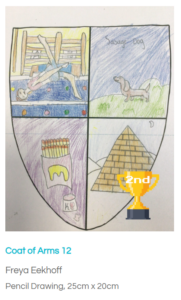
You can browse our 2023 entries to the Dot-Art Schools’ Competition at St Anne Stanley C of E Primary School | Schools | dot-art Schools
Art and Design Competition: Refugee Week
In partnership with the Merseyside Refugee Support Network, EMTAS invited schools to take part in a competition to create new artwork that challenges the myths and stereotypes surrounding Asylum Seekers and Refugees. The theme of the competition followed the Refugee Week’s focus of ‘We Cannot Walk Alone’. See below for a sample of our entries.
Art and Design Competition: Heroes Stamp Design Competition
Millions of key workers have kept the country going when most of us were told to stay home for our own safety. And there have been many people who volunteered to help people in their communities who needed support. There is no doubt that what these people did made them heroes, so Royal Mail wanted to honour them by producing a set of eight stamps.
The stamps will feature designs created by eight school-aged children. Royal Mail invited young designers to think about who their hero or heroes are, and to then design a stamp in their honour. A special panel of judges pick the winning designs. The final eight stamps are sent to Her Majesty The Queen before they can be printed and issued. See below for a sample of our entries.
St Anne’s Church Display: Identity
In celebration of the 2023 Year 6 Leavers’ Service, every Year 6 pupil drew a self portrait reflecting their inner and outer selves.
St Anne’s Church Display: Heroes of the Pandemic
Our children’s stamp designs were brought together and displayed in St Anne’s Church for our community to celebrate our heroes of the pandemic.
Art and Design Competition: Our Experience of an Extraordinary Time
The St Anne’s Art and Design competition invited our children to create a piece of artwork expressing their experience of this extraordinary time.
Congratulations to Saji in Year 3SW; the winner of our Art and Design competition. Her artwork captures the many aspects of our shared experience.
Congratulations to Betty in Year 2KB; her representation of our beautiful city during lockdown earned her a prize in our Art and Design competition.
Congratulations to prize-winner Zahra in Year 1ES; her artwork demonstrates the wonderful opportunities for arts and crafts we shared with our families during our time at home.
Well done to everyone who entered our Art and Design competition; our St Anne’s family are truly talented.
Scroll down to see a sample of creative works by our children together with the key learning for each year group. You will also find out about how we worked with local artist Ian Fennelly and how you can support your child’s learning at home.
View older tweets #stannestanleyArt
Gallery Visits and Workshops
Art and Design at St Anne Stanley draws on the wealth of galleries and artists local to our school. Over the course of our pupils time with us, their experience of Art and Design will be enriched through visits to local art galleries and visits from local artists. Take a look below to get a picture of enrichment in Art and Design.
Year 1
Visiting: Museum of Liverpool
Workshop: Best Buildings
A workshop beginning with a focus on ‘The Liverpool Cityscape’ painting. Pupils are encouraged to look closely at the painting and identify which city and river the painting shows. They are asked if they recognise features within the painting including buildings. Additional questioning focuses on colours, patterns, shapes, sounds that might be heard and how pupils feel about the painting. The workshop then moves to The People’s Republic gallery feature windows with views of the waterfront. Pupils are encouraged to spot some of the buildings and features they have just seen in the Liverpool Cityscape painting. The session finishes with an Art and Design activity where pupils create an artwork inspired by a building in Liverpool to take back to school.
Links to Art and Design Curriculum: Year 1 Landscapes Topic
Cross Curricular Links: Year 1 Geography Topic – Our School and Locality
Year 2
Workshop: Liverpool artist Laura-Kate Draws
A workshop centred around the areas of drawing and collage. Pupils apply their developing skills to create animal portraits using collage. Moreover, pupils meet and work with a local Liverpool artist, Through spending time with a working artist, pupils gain insight into the profession and inspiration for career opportunities in the field of Art and Design.
Links to Art and Design Curriculum: Year 2 Human Form Topic
Cross Curricular Links: Year 2 Science Topic – Animals Including Humans
Year 3
Workshop: Liverpool artist Laura-Kate Draws
A workshop centred around the areas of drawing and painting. Pupils undertake a portrait drawing activity looking at how to draw portraits incorporating some painting techniques. Moreover, pupils meet and work with a local Liverpool artist, Through spending time with a working artist, pupils gain insight into the profession and inspiration for career opportunities in the field of Art and Design.
Links to Art and Design Curriculum: Year 3 Skills Topic
Cross Curricular Links: Year 3 PSHE Topic – Diversity
Year 4
Workshop: Classroom Art Studio – We can work like an artist.
A workshop centred around developing skills in drawing and painting. Pupils take a closer look at key pieces of artwork associated with an artist that they have been learning about. Pupils are then taught the particular skills linked to that artist’s work e.g. the brush strokes associated with the works of Paul Cézanne, before applying what they have learnt to work like that artist.
Links to Art and Design Curriculum: Year 4 Skills Topic
Cross Curricular Links: Year 4 MFL – Learning about a French artist
Year 4
Visiting: Lady Lever Art Gallery
Self-led Visit
Links to Art and Design Curriculum: Using the language of Art and Design to evaluate works of art.
Cross Curricular Links: Year 4 History Topic – What was important to our local Victorians?
Year 5
Workshop: Willow Weaving
A workshop in which pupils use willow to weave crosses. In this craft activity, pupils develop their weaving skills together with working with a different medium.
Links to Art and Design Curriculum: Pupil develop their weaving skills in KS1 and Lower KS2. This workshop gives pupils in Upper KS2 the opportunity to build on weaving skills developed in KS1 and LKS2 together with broadening their experiences with a different form of art.
Cross Curricular Links: Year 5 Religious Education Topic – Why do Christians believe that Easter is a celebration of victory?
Year 6
Visiting: Walker Art Gallery
Workshop: Storytelling with the Greeks
A workshop in which pupils explore and evaluate a classic Greek painting, unlocking the story behind it before having an opportunity to create their own ending.
Links to Art and Design Curriculum: Using the language of Art and Design to evaluate works of art.
Cross Curricular Links: Year 6 History Topic – What did the Greeks do for us?
Autumn Term
Expressive Art and Design by the Early Years Foundation Stage
Year 1 Autumn Term Key Knowledge
 Year 1 Autumn Term Knowledge Organiser
Year 1 Autumn Term Knowledge Organiser
Year 1 Autumn Term: Skills
Through the topic of ‘Skills’, Year 1 explore the formal elements of colour and pattern. The children explore colour and pattern through drawing i.e. drawing around and overlapping 2D shapes to create an abstract composition, filling each shape with a different colour and medium. The children build on this drawing lesson through creating overlapping coloured/patterned designs in Lego printing. The children then explore colour and pattern through 3D form i.e. using playdough to mix the primary colours of red, blue and yellow to make secondary colours. The children continue to explore colour and pattern and develop their colour mixing skills through creating their own versions of the artwork ‘0-9’ by artist Jasper Johns. Building on these colour mixing lessons, the children begin to mix colours with greater precision. The children mix different hues of blue and yellow to create a piece of artwork before decorating their piece with dots, zigzags, stripes, wavy lines and shapes. Finally, the children apply the printing skills that they developed through Lego printing and explore colour and pattern through printing with a different medium. Here, the children use shaving foam and ink, to create a print representing the flames and beams of the Tudor houses.
Year 2 Autumn Term Key Knowledge
 Year 2 Autumn Term Knowledge Organiser
Year 2 Autumn Term Knowledge Organiser
Year 2 Autumn Term: Skills
Through the topic of ‘Skills’, Year 2 explore the formal elements of pattern and texture. The children explore pattern and texture through weaving. They use everyday objects to create repeating patterns, varying the direction of the pattern and the colours of the paint and paper. The children then explore pattern and texture through weaving. They overlap coloured strips of paper to create a checkerboard, before selecting a shape to overlay onto the weave and decorate. The children then explore pattern and texture through taking rubbings and through the technique of frottage. The children use a media of their choosing to take rubbings of textures which interest them before tearing and assembling their rubbings to make pictures in the style of artist Max Ernst. Finally, the children explore pattern and texture through creating a sculpture. The children use a variety of tools to create a uniquely patterned and textured clay tile.
Year 3 Autumn Term Key Knowledge
Year 3 Autumn Term Knowledge Organiser
Year 3 Autumn Term: Skills
Through the topic of ‘Skills’, Year 3 explore the formal elements of shape and tone. The children explore shape and tone through drawing. They use the four rules of shading to work evenly and neatly, in one direction, with straight edges and no gaps. Building on this lesson, the children use tone to create a contrasting image. The children study an object to identify the simple geometric shapes it’s made up of, before sketching out the details using light guidelines. The children then draw a teddy from observation, first positioning the object so they have their preferred vantage point, then sketching in the basic shape outlines before finally adding in details. Finally, the children explore shape and tone through craft. The children use a variety of materials to make a puppet. The children apply their understanding of shape to make the various parts of their puppets to the correct proportions and their understanding of tone in painting to create a life-like effect. Building on drawing geometric shapes as the basis for observational drawing, the children create shapes by drawing silhouettes to create shadow puppets before making and decorating a puppet theatre using recyclable materials.
Year 4 Autumn Term Key Knowledge
Year 4 Autumn Term Knowledge Organiser
Year 4 Autumn Term: Skills
Through the topic of ‘Skills’, Year 4 explore the formal elements of pattern and form. The children explore pattern and form through creating a patterned 3D effect. The children create an optical illusion piece of art, inspired by the ‘lenticular prints’ of Luz Perez Ojeda. The children then explore pattern and form through impressing a pattern onto a 3D form. The children design their own willow pattern style plate, based on a tale of their choice, by first drawing three key characters, then going over the details with undiluted ink, before finally using a water wash to add lighter tones of blue. Building on their skills in impressing patterns onto 3D forms, the children explore pattern and form through sculpture. The children use a variety of tools to carve a piece of soap into a sculpture in the style of artist and sculptor Barbara Hepworth. Building on this, the children explore pattern and form through painting and drawing. The children use patterned brush stroke techniques to paint in the style of artist Paul Cézanne, mixing colours using short, angular strokes and painting in various directions. Finally, the children create still life drawings in the style of Giorgio Morandi. The children apply their understanding of pattern and form to make their still life drawings look three-dimensional.
Year 5 Autumn Term Key Knowledge
Year 5 Autumn Term Knowledge Organiser
Year 5 Autumn Term: Architecture
Through the topic of ‘Architecture’, Year 5 explore the formal elements of line and tone. The children explore line and tone through drawing a house from observation. Building on this, the children explore line and tone through printing. They used ink to create a monoprint based on their own drawing. The children then explore line and tone through drawing with different media. The children use a variety of media to add vibrant colours to an image of a house in the style of Hundertwasser. The children then apply their skills to create a representation of a local landmark building in the style of Hundertwasser.
Year 6 Autumn Term Key Knowledge
Year 6 Autumn Term Knowledge Organiser
Year 6 Autumn Term: Make My Voice Heard
Through the topic of ‘Make my Voice Heard’, Year 6 explore the formal elements of line and tone. The children explore a variety of different types of lines and the effect of tone through Zengtangle patterns. The children then explore line and tone through graffiti art. The children design a graffiti tag with block letters including details such as serifs, contrasting colours and a 3D shadow effect. The children develop their skills in the formal elements of line and tone through drawing in the style of Käthe Kollwitz. They draw a portrait using lines to create emotional expression and charcoal to add shadows, experimenting with ‘halo’ and ‘chiaroscuro’ techniques. The children then explore line and tone through drawing and painting in the style of Pablo Picasso i.e. using tones of black, grey and white to create effect. Finally, the children apply their understanding of line and tone to sculpture. The children create sculptures based on their Kollwitz-inspired drawings.
Spring Term
Year 1 Spring Term Key Knowledge
Year 1 Spring Term Knowledge Organiser
Year 1 Spring Term: Landscapes using Different Media
Through the topic of ‘Landscapes using Different Media’, Year 1 develop their knowledge and skills in the formal elements of line and texture. The first lesson of this topic builds on lesson 1 of the autumn topic in which children drew around and overlapped 2D shapes to create an abstract composition. In this topic, the children begin by experimenting with composition and line through collage i.e. using shapes within shapes and overlapping shapes, to create a piece of abstract art inspired by artist Beatriz Milhazes. The children then explore line through drawing. They apply the principles of composition, developed in the previous lesson, to represent the horizon and tide lines in landscape artwork, inspired by artists Renoir, Sorolla and Krøyer.
Building on skills developed in lesson 1 and continuing to develop the artwork created in lesson 2, the children explore the formal element of texture through collage. They learn to identify different textures in a scene before using appropriate materials to replicate the range of textures. Building on the use of line in landscape art and continuing to develop the artwork created in lessons 2 and 3, the children develop their skills in the formal element of line through painting. They make different tints, shades and hues with paint, creating a tonal representation of the sea and sky (horizon and tide lines), understanding that light colours stand out more and darker colours recede. Building on colour mixing skills developed in the autumn topic and continuing to develop their piece of landscape art, the children explore texture through painting, they identify the colours used in an artist’s work, mixing colours to match these and using tools such as sponges to apply the colours onto a textured surface. Finally, the children explore the formal element of texture through collage. They apply skills developed throughout the topic (creating tonal representations with paint and adding texture using collage) to complete their piece of landscape art.
Year 2 Spring Term Key Knowledge
Year 2 Spring Term Knowledge Organiser
Year 2 Spring Term: Human Form
Through the topic of ‘Human Form’, Year 2 develop their knowledge and skills in the formal elements of tone and space. The children begin by exploring tone through drawing. They learn to control a pencil to create dark and light tones, shading without any gaps and within the lines. Building on this lesson, the children apply their skills in the formal element of tone to create a 3D effect. They experiment with pencils to create different tones. Using different gradients of pencil in the style of Ed Ruscha, the children learn to use these different tones to make a drawing look three dimensional. Building on the previous lessons in tone and inspired by the work of Damien Hirst, the children create a colourful 3D image of a skull. Here, the children learn about the use of space in creating an image, that is, the distances or areas around, between and within components of a piece.
Continuing with a focus on facial features, the children explore space through collage. They learn how to create a collage of facial features with attention to proportion and space. The children then apply their skills in the formal element of space through drawing. Maintaining the focus on facial features the children create a self-portrait in the style of Julian Opie by drawing long lines to outline the face, head, neck and hair, and adding facial features using dots and short lines. Finally, the children explore proportion through craft. They apply their understanding of proportion developed in the previous lessons through creating a proportionate figure of a human form. In particular, the children make a clothes peg figure from a variety of materials in the style of craftsperson Edwina Bridgeman.
Year 3 Spring Term Key Knowledge
Year 3 Spring Term Knowledge Organiser
Year 3 Spring Term: Prehistoric Art
Through the topic of Prehistoric Art, Year 3 develop their knowledge and skills in the formal elements of colour and texture. The children begin by exploring colour through painting. They build on their colour mixing skills by mixing their own colours to create a contrasting image. They learn about blending tones through the work of Diego Velázquez (‘An Old Woman Cooking Eggs’). The children then explore colour through drawing. Building on their understanding of proportion developed in the autumn term (e.g. developing proportionate sketches of teddy bears), the children use muted earth colours to create a proportionate drawing of an animal in the style of prehistoric man made art. The children then explore texture through drawing with a different media. They scale up their drawing (from the previous lesson) using a different medium, identifying key 2D shapes within the image and applying and blending charcoal to create texture.
Continuing to develop their piece of artwork created in the previous lessons, the children explore colour and texture through painting. They create a textured background using natural materials (eg. lentils, seeds, sand etc.) before painting onto their textured backgrounds using natural ingredients (e.g. spices such as paprika, turmeric and cinnamon). The children paint a picture of the animal drawing they have developed over the previous lessons. Finally, the children explore colour and texture through printing. They create a collaborative piece of artwork using both positive and negative impressions on a textured background.
Year 4 Spring Term Key Knowledge
Year 4 Spring Term Knowledge Organiser
Year 4 Spring Term: Sculpture
Through the topic of ‘Sculpture’ Year 4 explore the formal elements of pattern and form. The children begin by exploring pattern through printing. They make stamps to create repeating and symmetrical patterns, varying configurations and their use of colour. The children then explore pattern through drawing. They apply the techniques of reflection and symmetry to create a flip pattern. The children continue to explore pattern through drawing by using a compass to recreate the flower of life pattern.
The children then explore pattern and form through craft. They use recycled materials to construct an instrument before decorating this 3D form with a pattern of consistent size and shape. Finally, the children explore pattern and form through sculpture. Inspired by the work of El Anatsui, they create an abstract sculpture from recycled materials, arranging the materials into patterns.. The children then explore form through the sculptures of Sokari Douglas Camp, they create a sculpture of a word (which they consider powerful or significant) using recycled materials, drawing block letters with a focus on composition.
Year 5 Spring Term Key Knowledge
Year 5 Spring Term Knowledge Organiser
Year 5 Spring Term: Design for a Purpose
Through the topic of’ ‘Design for a Purpose’, Year 5 apply the formal elements of art to the process of design. The children begin by applying the formal elements of art to design an invention. Inspired by the inventions of Leonardo da Vinci and Dominic Wilcox, the children design a new invention for a set purpose by brainstorming ideas and developing and communicating these through notes and sketches, with reference to shape, colour and pattern. The children select one idea to draw and annotate in full. The children then apply the formal elements of art to design a coat of arms.
With reference to space, shape, colour and pattern, they design a coat of arms by selecting and placing imagery appropriately within a shape. The children then explore the use of shape, pattern and colour in the designs of Morag Myerscough and Luke Morgan before working collaboratively to design a space. Finally, the children apply the formal elements of art to design a product.. They work in a team to design a product, using advertising logos, USPs and packaging to give their product an identity. The children draw their product in 2D or add their design to an existing 3D shape, before ‘selling’ their product idea to a ‘client’.
Year 6 Spring Term Key Knowledge
Year 6 Spring Term Knowledge Organiser
Year 6 Spring Term: Still Life
Through the topic of ‘Still Life’, Year 6 explore the formal elements of composition and tone. The children begin by analysing the formal elements within a piece of artwork. They analyse works of art such as Edward Hopper’s ‘Nighthawks’, answering questions on fundamental principles in art, including; scene, technique, form and shape, colour and light. Inspired by the still life works of Cezanne’s ‘Still Life with Apples’, Funke’s ‘Composition – glass and ball’, and Nicholson’s ‘1946 (still life)’, the children arrange and sketch their own selection of objects with a focus on composition. The children then explore tone through drawing with a different media. Inspired by Camargo’s abstract piece ‘Still Life 15’ in which the shapes and lines are simplified and the colours are reduced to greys, the children recreate their still life drawing (from the previous lesson) using the medium of charcoal.
The children continue to explore composition and tone through drawing with a different media. They create a negative image (of their still life artwork from the previous lessons) by using an eraser to define lines and shapes and mark out areas of light and shadow. The children then explore composition and tone through painting their still life piece. They mix and apply paint to add dynamic colour to their still life artwork with a range of tints and hues. Finally, the children explore composition through 3D sculpture, that is, they make decisions about the composition of their still life artworks in 3D form. The children showcase their work in 3D form by creating a box with a different still life piece on each face together with a visual representation of the memories and emotions they evoke.
Summer Term
Recovery Curriculum
As part of our summer term topic, we covered critical knowledge and skills drawn from the spring term topics. Through weaving key content into current learning, our children were supported to achieve the high expectations set in our Art and Design curriculum.
Year 1 Flashback – Recovery Curriculum
Year 2 Flashback – Recovery Curriculum
Year 3 Flashback – Recovery Curriculum
Year 4 Flashback – Recovery Curriculum
Year 5 Flashback – Recovery Curriculum
Year 6 Flashback – Recovery Curriculum
Expressive Art and Design by the Early Years Foundation Stage
Year 1 Summer Term Key Knowledge
Year 1 Summer Term Knowledge Organiser
Year 1 Summer Term: Sculpture
Through the topic of ‘Sculpture’, Year 1 develop their knowledge and skills in the formal elements of line and form. The first lesson of this topic builds on the drawing skills developed lesson 1 of the autumn topic (Drawing: Experimenting with Different Media) and lesson 1 of the spring topic (Shape: Abstract Compositions). In the first lesson of the topic, the children explore line through drawing. They experiment with composition to create a piece of abstract art by arranging pieces of string into different shapes before drawing these from observation, as inspired by the artist Bridget Riley.
Building on lesson 1 through applying their understanding of the formation of lines, the children explore form through collaboratively creating a symmetrical sculpture using paper and other materials. The children create different parts of a sculpture using a range of materials before securing the parts of the sculpture together, as inspired by the large scale sculptures created by Louise Bourgeois e.g. the ‘Maman’ Sculpture. The children continue to develop this sculpture through using different tools and techniques to paint onto the 3D surface. Building on the drawing skills developed in lesson 1. the children revisit exploring line through drawing. They use a variety of different mediums to make different types of lines, as inspired by artists David Hockney and Vija Celmins. Building on this lesson, the children apply their understanding of the formation of wavy lines to creating a snail sculpture. The children explore form through creating this sculpture using clay. The children sketch a pattern from observation before creating a sculpture of a snail using etching tools.
Year 2 Summer Term Key Knowledge
Year 2 Summer Term Knowledge Organiser
Year 2 Summer Term: Sculpture and Mixed Media
Through the topic of ‘Sculpture and Mixed Media’, Year 2 explore the formal elements of colour and form. Building on the use of tone to create 3D effects in the previous topic, the children explore colour and form through drawing. The children use a range of mediums to create colourful tones, using these tones to make their drawing look three dimensional. Building on their understanding of 3D effects, the children turn a 2D drawing into a 3D model. The children sketch a person before using wire and plasticine to turn their drawings into a three dimensional form. Here, the children apply their understanding of proportion developed in the previous topic (creating clothes peg figures) to create a human form using a different media.
At this point in the topic, the children have drawn a 2D form of a human figure and turned this into a 3D model. The children now scale their drawings up to a life-size image of a human form (building on tracing skills developed in the previous topic) before adding form (3D effects to make the piece pop). The children create this composition with figures, splashes and action words, adding texture, colour and pattern to their piece in the style of artist Roy Lichtenstein.
Year 3 Summer Term Key Knowledge
Year 3 Summer Term Knowledge Organiser
Year 3 Summer Term: Craft
Through the topic of ‘Craft’, Year 3 explore the formal elements of colour and pattern. The children first explore colour and pattern through gathering inspiration for the topic. In the first lesson, the children design and construct a mood board by selecting and curating carefully chosen fabrics, pictures, photographs, words and textures together with a personal palette of favourite colours. The children then explore colour and pattern through craft. They use the process of tie-dyeing to decorate a t-shirt, mixing dyes to create a range of colours and tying in different ways to create unique patterns.
The formal elements of colour and pattern are then explored through weaving. Building on children’s experience of weaving in Year 2, the children create weave patterns using the warp and weft technique. Using their weaving skills from the previous lesson and their tie-dyed materials from a previous lesson, the children create weave patterns with fabric using a loom. Finally, the children explore colour and pattern through sewing. Using their tie-dyed t-shirt from a previous lesson, the children use a running stitch to sew a shape or fabric weave onto the front of their t-shirt, the design of which is inspired by their mood board.
Year 4 Summer Term Key Knowledge
 Year 4 Summer Term Knowledge Organiser
Year 4 Summer Term Knowledge Organiser
Year 4 Summer Term: Every Picture Tells a Story
Through the topic of ‘Every Picture Tells a Story’, Year 4 analyse abstract and narrative artworks through the formal elements. Over the course of the topic, the children practice techniques for creating abstract art and create a piece of abstract artwork. In the first lesson, the children develop techniques in creating abstract works of art. The children express the meaning of words and phrases in an abstract way, using charcoal to create different textures and effects.
The children analyse the formal elements in ‘My Parents’ by David Hockney and explore the use of narrative through acting out the scene within the painting. They analyse the formal elements and the use of narrative in the work of Paula Rego’s ‘The Dance’ with a focus on justifying opinions by referencing specific aspects of the painting. The children analyse the formal elements and the use of narrative in the realist work of Edward Hopper e.g. ‘Table for Ladies’, using role-play to view the piece from another perspective. The children analyse the formal elements and use of narrative in Pieter Brueghel’s painting ‘Children’s Games’ before recreating it as modern art in the form of a photo collage. Finally the children analyse the formal elements and use of narrative in Fiona Rae’s paintings before creating their own abstract piece to represent their chosen themes.
Year 5 Summer Term Key Knowledge
Year 5 Summer Term Knowledge Organiser
Year 5 Summer Term: Every Picture Tells a Story
Through the topic of ‘Every Picture Tells a Story’, Year 5 explore the formal elements of line and tone. The children begin by exploring line and tone through drawing. They work imaginatively to develop an idea of their own through sketching and sourcing pictures, photos and illustrations, before producing a final drawing. The children continue to explore line and tone through drawing a portrait using the continuous line method. The children add text inspired by a poem to their protrait, varying the size and style of their writing to suit the details of their picture. The children then explore the political messages within art through the work of Banksy (‘Clacton Pigeon Mural’) before altering a work of art to reflect British Values.
The children explore line and tone through painting. They create a symmetrical abstract image in the style of the Rorschach method, as inspired by Andy Warhol (‘Rorschach’). The children then analyse the use of formal elements including line and tone in a piece of artwork. In particular, the children analyse and re-create a political piece of artwork by John Singer Sargent (‘Gassed’). Finally, the children explore line and tone through drawing with a different media. The children work in an unconventional manner, as inspired by Magdalene Odundo, using coloured chalk and their whole bodies to create different lines and tones.
Year 6 Summer Term Key Knowledge
Year 6 Summer Term Knowledge Organiser
Year 6 Summer Term: Photography
Through the topic of ‘Photography’, the children explore the formal elements of colour and line. The children explore colour through painting (mixing complex colours in the style of Claude Monet). The children then explore colour and line through photomontage. They create a photomontage by selecting and manipulating images, as inspired by photomontage artists such as Hannah Hoch. The children then explore colour and line through digital photography. They create a piece of art by matching a truism with a photograph that mirrors its message, employing the digital techniques used by contemporary artists such as Jenny Holzer. The children continue to explore colour and line through photography. They create and edit a close up photograph of a natural form in the style of Edward Weston.
In the final lessons of this topic, the children explore colour and line through drawing and painting. The children develop a self-portrait photograph into a line drawing using the continuous line method. The children then create a piece of art by adding an expressive photo self-portrait to a background created in another medium, as inspired by the work of Edvard Munch.
Our Visiting Artist
Click on the image above to find out more about our visiting artist. Artist Ian Fennelly visited our school and worked with our children, parents and staff to develop our knowledge, understanding and skills in the area of sculpture.
Artist Ian Fennelly working with Year 1MS
Year 1MS used empty milk bottles to create sculptures that represent the pupils of St Anne (Stanley). Linking to our PSHE curriculum, we celebrated our similarities and differences.
Our parents came along to our workshop. We don’t know who enjoyed it more!
Artist Ian Fennelly working with Yr6N
Yr6N worked with wire and tape to create intricate coral reef sculptures, linked to their geography topic ‘Are we damaging our world?’
Curriculum Booklets to Support your Child’s Learning at Home
Additional Resources to Support your Child’s Learning at Home
Click on the image above to access resources from ‘Tate for Children’. You can support your child to further develop their art and design skills through free instructional activities based on painting, drawing, sculpture and much more! You can also support your child to further develop their knowledge and understanding of art and design through free online games and quizzes.
Click on the image above to access BBC Bitesize Art and Design where your child can explore famous works of art together with learning about the history of art. You can support your child to enhance their developing knowledge and skills in a variety of media including paint, drawing and 3D sculpture. Your child can also enhance their understanding of the formal elements of art including colour, pattern and texture.



